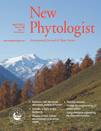Ver ítem
- xmlui.general.dspace_homeCentros Regionales y EEAsCentro Regional Patagonia SurEEA Santa CruzArtículos científicosxmlui.ArtifactBrowser.ItemViewer.trail
- Inicio
- Centros Regionales y EEAs
- Centro Regional Patagonia Sur
- EEA Santa Cruz
- Artículos científicos
- Ver ítem
Correlations between physical and chemical defences in plants: tradeoffs, syndromes, or just many different ways to skin a herbivorous cat?
Resumen
Most plant species have a range of traits that deter herbivores. However, understanding of how different defences are related to one another is surprisingly weak. Many authors argue that defence traits trade off against one another, while others argue that they form coordinated defence syndromes. We collected a dataset of unprecedented taxonomic and geographic scope (261 species spanning 80 families, from 75 sites across the globe) to investigate
[ver mas...]
Most plant species have a range of traits that deter herbivores. However, understanding of how different defences are related to one another is surprisingly weak. Many authors argue that defence traits trade off against one another, while others argue that they form coordinated defence syndromes. We collected a dataset of unprecedented taxonomic and geographic scope (261 species spanning 80 families, from 75 sites across the globe) to investigate relationships among four chemical and six physical defences. Five of the 45 pairwise correlations between defence traits were significant and three of these were tradeoffs. The relationship between species’ overall chemical and physical defence levels was marginally nonsignificant (P = 0.08), and remained nonsignificant after accounting for phylogeny, growth form and abundance. Neither categorical principal component analysis (PCA) nor hierarchical cluster analysis supported the idea that species displayed defence syndromes. Our results do not support arguments for tradeoffs or for coordinated defence syndromes. Rather, plants display a range of combinations of defence traits. We suggest this lack of consistent defence syndromes may be adaptive, resulting from selective pressure to deploy a different combination of defences to coexisting species.
[Cerrar]

Autor
Moles, Angela;
Peco, Begoña;
Wallis, Ian R.;
Foley, William J.;
Poore, Alistair G.B.;
Seabloom, Eric William;
Vesk, Peter A.;
Bisigato, Alejandro Jorge;
Cella Pizarro, Lucrecia;
Clark, Connie J.;
Cohen, Philippe S.;
Cornwell, William K.;
Edwards, Will;
Ejrnæs, Rasmus;
Gonzales‐Ojeda, Therany;
Graae, Bente J.;
Hay, Gregory;
Lumbwe, Fainess C.;
Magaña‐Rodríguez, Benjamín;
Moore, Ben D.;
Peri, Pablo Luis;
Poulsen, John R.;
Stegen, James C.;
Veldtman, Ruan;
Zeipel, Hugo von;
Andrew, Nigel R.;
Boulter, Sarah L.;
Borer, Elizabeth T.;
Cornelissen, Johannes H.C.;
Farji Brener, Alejandro Gustavo;
DeGabriel, Jane L.;
Jurado, Enrique;
Kyhn, Line A.;
Low, Bill;
Mulder, Christa P.H.;
Reardon Smith, Kathryn;
Rodrıguez Velazquez, Jorge;
De Fortier, An;
Zheng, Zheng;
Blendinger, Pedro Gerardo;
Enquist, Brian J.;
Facelli, Jose M.;
Knight, Tiffany;
Majer, Jonathan D.;
Martinez Ramos, Miguel;
McQuillan, Peter;
Hui, Francis K.C.;
Fuente
New Phytologist 198 (1) : 252-263 (April 2013)
Fecha
2013-04
Editorial
Wiley
ISSN
0028-646X
1469-8137
1469-8137
Formato
pdf
Tipo de documento
artículo
Palabras Claves
Derechos de acceso
Restringido
 Excepto donde se diga explicitamente, este item se publica bajo la siguiente descripción: Creative Commons Attribution-NonCommercial-ShareAlike 2.5 Unported (CC BY-NC-SA 2.5)
Excepto donde se diga explicitamente, este item se publica bajo la siguiente descripción: Creative Commons Attribution-NonCommercial-ShareAlike 2.5 Unported (CC BY-NC-SA 2.5)

